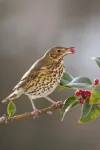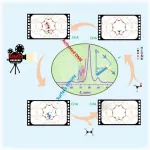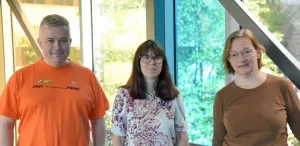(Press-News.org) Researchers rescued mice from early death caused by a muscle-weakening disease, not by correcting the flawed gene that causes it, but instead by targeting another protein in the same signaling pathway.
Led by NYU Grossman School of Medicine researchers, a new study found that an antibody treatment not only rescued young mice from a form of congenital myasthenia (CM) but also reversed disease relapse in adult mice.
Published online in the journal Nature on June 23, the study revealed new details of the cause of CM, with the better understanding guiding the team's design for a therapeutic antibody treatment.
Mice with the type of CM in the current study fail to develop nerve-muscle connections called synapses that trigger the muscle contractions required for movement, including breathing, and so die soon after birth. Human newborns with CM often survive but face severe, life-long muscle weakness. The few available treatments only partially abate the symptoms.
"To our knowledge, our study is the first to fully counter a lethal congenital flaw by targeted therapy, restoring synapse formation with an antibody that encourages the action of a protein downstream of the mutant gene," says lead author Steven J. Burden, PhD, professor in the Skirball Institute and Department of Neuroscience and Physiology at NYU Langone Health.
"While this strategy applies directly to a rare set of neuromuscular diseases studied here, the findings suggest new approaches to more common diseases - like amyotrophic lateral sclerosis , also called ALS or Lou Gehrig's disease, spinal muscular atrophy, and autoimmune myasthenia gravis ," adds Burden, also a professor in the Department of Cell Biology.
Deep Knowledge Required
Past studies had linked many cases of CM to genetic errors in a gene called Dok7, which codes for a protein that is crucial to the formation of synapses. Dok7 is an adapter protein that becomes attached to a key enzyme, muscle-specific kinase (MuSK). Discovered by the Burden lab in 1993, MuSK has been studied by many labs over the past two dozen years.
Once attached to MuSK, Dok7 is modified, such that new attachment sites appear in Dok7, leading to the recruitment of other proteins crucial to the building of the neuromuscular synapse. In addition, past studies by the Burden lab and others had shown that Dok7 is not only a target of MuSK but also a stimulator of MuSK, helping to keep MuSK activated.
The most common disease-causing mutation in the Dok7 gene produces an abnormal, shorter form of the Dok7 protein. Past theories held that this common mutation caused CM by removing the part of Dok7 with the attachment sites for other proteins, thereby preventing assembly of the cellular machinery for building neuromuscular synapses. The current research team, however, determined that this common form of CM was caused not by the loss of Dok7 attachment sites, but instead because the shortened version of Dok7 was produced in modestly lower amounts. Consequently, there was not enough Dok7 to activate MuSK.
With the surprising CM mechanism clarified, the team used their understanding of MuSK to design synthetic antibodies that boosted the action of MuSK. The goal was to learn whether such antibodies could rescue mice with the Dok7 mutation. Engineered versions of antibodies are widely used as therapeutics, which represent a more practical approach than replenishing muscle cells with a healthy Dok7 protein by gene therapy, say the study authors.
Based on the team's deep knowledge of MuSK biology, study author Shohei Koide, PhD, professor in the Perlmutter Cancer Center at NYU Langone Health and Department of Biochemistry and Molecular Pharmacology, and colleagues designed a strategy to find antibodies that attached to just the right region of mouse and human MuSK in order to activate MuSK without blocking its normal functions.
The team identified several such antibodies, including one they called X17, which rescued neuromuscular synapse formation, and reversed the movement deficits and early lethality of mice with Dok7 CM. Most of the antibody-treated mice grew to fertile adults. Further, when the team withdrew the antibody treatment, adult mice relapsed and displayed movement problems, which were reversed by re-starting antibody treatment.
According to the authors, the study results indicate that their therapeutic approach rescues synapses not only when they first form during development but also reverses synaptic dysfunction in adult animals. The say their ultimate goal would be to develop the capability to treat children and adults with congenital myasthenia as soon as they are diagnosed.
INFORMATION:
Along with Burden and Koide, study authors from NYU Langone Health included first authors Julien Oury and Wei Zhang from the Skirball Institute of Biomolecular Medicine, as well as Nadia Leloup, Akiko Koide, Alexis Corrado, Gayatri Ketavarapu, and Takamitsu Hattori of the Perlmutter Cancer Center. The work was supported by National Institute of Neurological Disorders and Stroke grants RO1 NS075124 and R37 NS36193 and by funds from the Colton Center for Autoimmunity at NYU Langone Health.
Burden is an inventor on patent no. 9,329,182, titled "Method of treating motor neuron disease with an antibody that agonizes MuSK", while Burden, Shohei Koide, Akiko Koide, Oury, and Leloup are inventors on a patent application no. 1474662.02232, "Therapeutic MuSK Antibodies." These patents have been licensed to argenx, with the relationship managed in line with the policies of New York University.
ITHACA, N.Y. - Scientists at Cornell University and the American Museum of Natural History have identified 2,034 nearby star-systems - within the small cosmic distance of 326 light-years - that could find Earth merely by watching our pale blue dot cross our sun.
That's 1,715 star-systems that could have spotted Earth since human civilization blossomed about 5,000 years ago, and 319 more star-systems that will be added over the next 5,000 years.
Exoplanets around these nearby stars have a cosmic front-row seat to see if Earth holds life, the scientists said in research published June 23 in Nature.
"From the exoplanets' point-of-view, we are the aliens," said Lisa Kaltenegger, professor of astronomy and director of Cornell's Carl Sagan ...
What The Study Did: Hospital employees were surveyed about symptoms such as a rash, itching, hives or swelling around the face after receiving a messenger RNA COVID-19 vaccine.
Authors: Lacey B. Robinson, M.D., M.P.H., of Massachusetts General Hospital in Boston, is the corresponding author.
To access the embargoed study: Visit our For The Media website at this link https://media.jamanetwork.com/
(doi:10.1001/jamadermatol.2021.2114)
Editor's Note: The article includes conflicts of interest and funding/support disclosures. Please see the article for additional information, including other authors, ...
BOSTON - Skin problems such as itchiness, rashes, hives and swelling can occur in some individuals after receiving a COVID-19 vaccine, but it's not clear how common these reactions are or how frequently they recur with a subsequent vaccination. Research by led by allergists at Massachusetts General Hospital (MGH) now provides encouraging indications that the reactions are rare, and that even when they do occur with an initial COVID-19 vaccination, they seldom recur after receiving a second vaccine dose.
For the study, which is published in
JAMA Dermatology, a team led by Kimberly G. Blumenthal, MD, MSc, co-director of the Clinical Epidemiology Program within MGH's ...
What The Study Did: Researchers investigated the association between counties that adopted state mask mandates in Kansas with COVID-19 cases, hospitalizations and deaths.
Authors: Donna K. Ginther, Ph.D., of the University of Kansas in Lawrence, is the corresponding author.
To access the embargoed study: Visit our For The Media website at this link https://media.jamanetwork.com/
(doi:10.1001/jamanetworkopen.2021.14514)
Editor's Note: The article includes funding/support disclosures. Please see the article for additional information, including other authors, author contributions ...
What The Study Did: The hours worked and patterns of work activities among U.S. physicians before and during the COVID-19 pandemic were examined in this study.
Authors: Xiaochu Hu, Ph.D., of the Association of American Medical Colleges in Washington, D.C., is the corresponding author.
To access the embargoed study: Visit our For The Media website at this link https://media.jamanetwork.com/
(doi:10.1001/jamanetworkopen.2021.14386)
Editor's Note: Please see the article for additional information, including other authors, author contributions and affiliations, conflict ...
What The Study Did: Researchers examined family voucher-based kidney donations and the capability of voucher redemption to provide timely kidney transplants.
Authors: Jeffrey L. Veale, M.D., of the University of California, Los Angeles, is the corresponding author.
To access the embargoed study: Visit our For The Media website at this link https://media.jamanetwork.com/
(doi:10.1001/jamasurg.2021.2375)
Editor's Note: The article includes conflict of interest disclosures. Please see the article for additional information, including other authors, author contributions and affiliations, conflict of interest and ...
Migratory birds carry most seeds in the wrong direction to help plants cope with climate change, new research shows.
The study, published in Nature, reveals that the vast majority of plants from European woodlands are dispersed by birds migrating to warmer latitudes in the south, while far fewer are dispersed by birds migrating north.
As a consequence of global warming, the optimal climatic conditions of species are moving towards cooler latitudes, forcing the redistribution of life on Earth.
Mobility allows many animals to reach new areas with a suitable climate.
However, movement of plant species depends on the dispersal of their seeds at long ...
CHAPEL HILL, NC--Researchers at the University of North Carolina at Chapel Hill and the UNC Lineberger Comprehensive Cancer Center have uncovered a new mechanism that activates specific genes, leading to the development of cancers.
They showed that a mutation that fuses two unrelated genes can promote a process similar to that observed when oil and water are mixed but do not blend together. The process, called liquid-liquid phase separation, occurs inside a cell's nucleus and enables the formation of compartments with various physical properties that can promote cancers such as acute leukemias. Their findings will be published online June 23, 2021, in Nature.
"Phase separation and its role in cancer has been a missing puzzle piece in understanding this disease," said UNC Lineberger's ...
A joint research team led by Prof. LIU Zhongmin, Prof. WEI Yingxu, and Prof. XU Shutao from the Dalian Institute of Chemical Physics (DICP) of the Chinese Academy of Sciences (CAS) revealed the mechanism underlying the formation of the first carbon-carbon (C-C) bond formation during the methanol-to-olefins (MTO) process.
This study was published in Chem on June 23.
Prof. ZHENG Anmin's group from Innovation Academy for Precision Measurement Science and Technology of CAS was also involved in the study.
The first C-C bond in the MTO process is formed at the initial stage of the reaction. There is no direct method to elucidate the bond formation /reaction mechanism due to the difficulty in capturing intermediate species.
"We investigated the ...
A paper published in the prestigious journal Nature Medicine on long-COVID, describes persistent symptoms six months after acute COVID-19, even in young home isolated people.
The study from the Bergen COVID-19 Research Group followed infected patients during the first pandemic wave in Bergen Norway.
"The main novel finding is that more than fifty per cent of young adults up to 30 years old, isolated at home, still have persistent symptoms six months after mild to moderate disease", the leader of the group, Professor Nina Langeland explains.
The most common symptoms were loss of smell and/or taste, fatigue, ...



